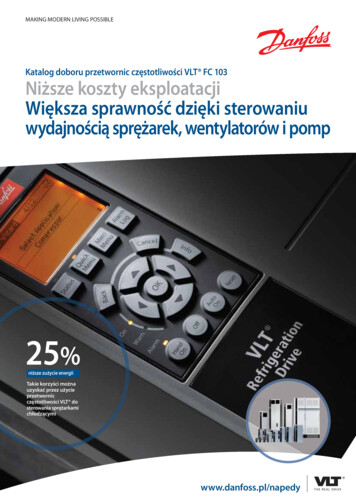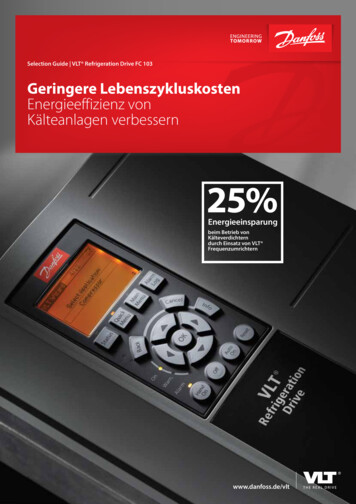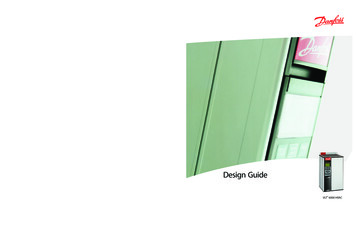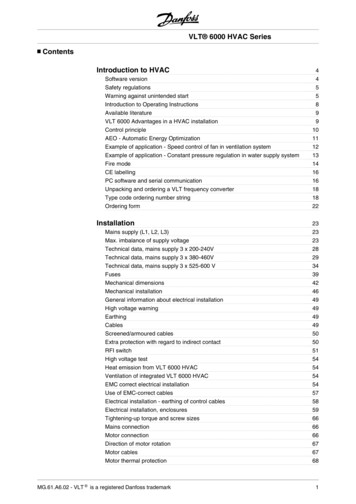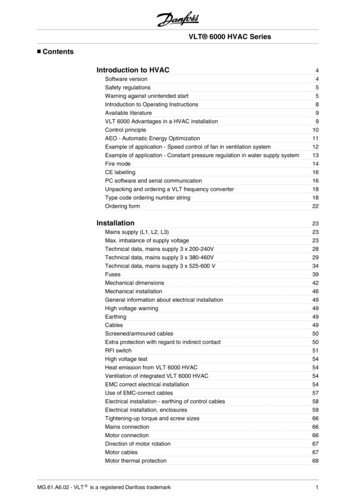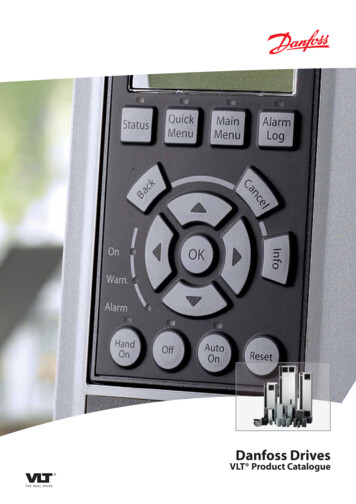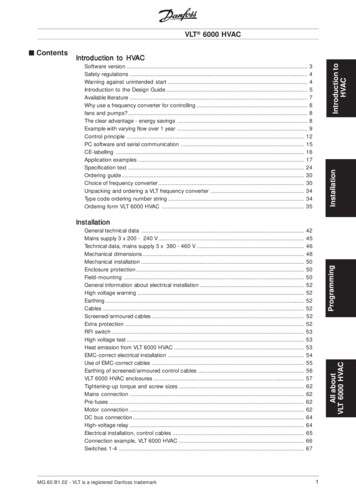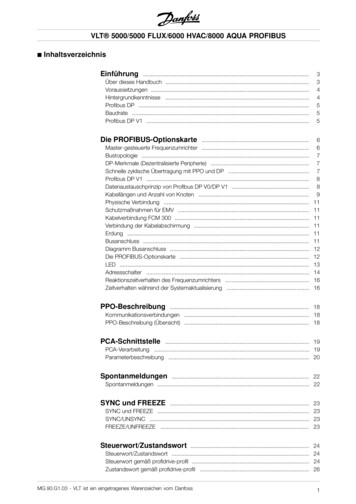
Transcription
VLT 6000 HVAC SeriesContentsIntroduction to HVACSoftware versionSafety regulationsWarning against unintended startIntroduction to the Design GuideAvailable literatureFire modeStar/delta starter or soft-starter not requiredControl principleCE labellingThe new standardThe new standardThe new standardChoice of frequency converterUnpacking and ordering a VLT frequency converterType code ordering number stringOrdering formPC software and serial communicationPC Software toolsFieldbus optionsProfibusLON - Local Operating NetworkDeviceNetModbus RTUInstallationMains supply (L1, L2, L3)Max. imbalance of supply voltageTechnical data, mains supply 3 x 200-240VTechnical data, mains supply 3 x 380-460VTechnical data, mains supply 3 x 525-600 VFusesMechanical dimensionsMechanical installationGeneral information about electrical installationHigh voltage warningEarthingCablesScreened/armoured cablesExtra protection with regard to indirect contactRFI switchHigh voltage testHeat emission from VLT 6000 HVACVentilation of integrated VLT 6000 HVACEMC correct electrical installationUse of EMC-correct cablesElectrical installation - earthing of control cablesMG.61.B6.02 - VLT is a registered Danfoss 4414141464752576064676767676868697272727274751
VLT 6000 HVAC SeriesElectrical installation, enclosuresTightening-up torque and screw sizesMains connectionMotor connectionDirection of motor rotationMotor cablesMotor thermal protectionEarth connectionInstallation of 24 Volt external DC supplyDC bus connectionHigh-voltage relayControl cardElectrical installation, control cablesSwitches 1-4Bus connectionConnection examples, VLT 6000 HVACProgrammingControl unit LCPControl keysfor parameter setupIndicator lampsLocal controlDisplay modeNavigation between display modesChanging dataManual initialisationQuick MenuOperation and Display 001-017The Setup configurationSetup of user-defined readoutLoad and Motor 100-117ConfigurationMotor power factor (Cos ø)Reference handlingReference typeInputs and outputs 300-365Analogue inputsAnalog/digital outputsRelay outputsApplication functions 400-427Sleep modePID for process controlPID overviewFeedback handlingSerial communication for FC protocolProtocolsTelegram communicationTelegram build-up under FC protocolData character 1143143150150150151152MG.61.B6.02 - VLT is a registered Danfoss trademark
VLT 6000 HVAC SeriesProcess wordControl word according to FC protocolStatus word as per FC protocolSerial communication referencePresent output frequencySerial communication 500 - 556Extended status word, warning word, and alarm wordService functions 600-631Electrical installation of the relay cardDescription of Real Time ClockAll about VLT 6000 HVACStatus messagesList of warnings and alarmsAggressive environmentsCalculation of resulting referenceGalvanic isolation (PELV)Earth leakage currentExtreme running conditionsPeak voltage on motorSwitching on the inputAcoustic noiseDerating for ambient temperatureDerating for air pressureDerating for running at low speedDerating for long motor cables or cables with larger cross-sectionDerating for high switching frequencyVibration and shockAir humidityEfficiencyMains supply interference/harmonicsPower factor(Emission)EMC ImmunityDefinitionsParameter overview and factory settingsIndexMG.61.B6.02 - VLT is a registered Danfoss 971971992012032103
VLT 6000 HVAC SeriesSoftware versionVLT 6000 HVACDesign GuideSoftware version: 3.2xThis Design Guide can be used with all VLT 6000 HVAC frequency converters with software version 3.2x.The software version number can be seen from parameter 624.4MG.61.B6.02 - VLT is a registered Danfoss trademark
VLT 6000 HVAC SeriesThe Protective Extra Low Voltage (PELV)requirements stated in IEC 61800-5-1 arenot fulfilled at altitudes above 2000 m(6562 ft.). For 200V frequency convertersthe requirements are not fulfilled at altitudes above 5000 m (16 404 ft.). Pleasecontact Danfoss Drives for further information.6.Do not remove the plugs for the motor andmains supply while the frequency converteris connected to mains. Check that the mainssupply has been disconnected and that thenecessary time has passed before removingmotor and mains plugs.7.Reliable galvanic isolation (PELV) is notcomplied with if the RFI switch is placed inOFF position. This means that all control in and outputs can only be considered low-voltage terminals with basic galvanic isolation.8.Please note that the frequency converter hasmore voltage inputs than L1, L2 and L3, whenthe DC-bus terminals are used.Check that all voltage inputs have been disconnected and that the necessary time haspassed before repair work is commenced.Safety regulations1.2.3.The frequency converter must be disconnected from mains if repair work is to be carriedout. Check that the mains supply has beendisconnected and that the necessary timehas passed before removing motor andmains plugs.The [OFF/STOP] key on the control panel ofthe frequency converter does not disconnectthe equipment from mains and is thus not tobe used as a safety switch.Correct protective earthing of the equipmentmust be established, the user must be protected against supply voltage, and the motormust be protected against overload in accordance with applicable national and localregulations.4.The earth leakage currents are higher than3.5 mA.5.Protection against motor overload is includedin the factory setting. Parameter 117, Motorthermal protection default value is ETR trip 1.MG.61.B6.02 - VLT is a registered Danfoss trademarkWarning against unintended start1.The motor can be brought to a stop by meansof digital commands, bus commands, references or a local stop, while the frequencyconverter is connected to mains.If personal safety considerations make it necessary to ensure that no unintended startoccurs, these stop functions are not sufficient.2.While parameters are being changed, themotor may start. Consequently, the stop key[OFF/STOP] must always be activated, following which data can be modified.3.A motor that has been stopped may start iffaults occur in the electronics of the frequency converter, or if a temporary overload or afault in the supply mains or the motor connection ceases.5Introduction to HVACThe voltage of the frequency converter isdangerous whenever the equipment isconnected to mains. Incorrect installationof the motor or the frequency convertermay cause damage to the equipment, serious personal injury or death.Consequently, the instructions in thismanual, as well as national and local rulesand safety regulations, must be compliedwith.Note: The function is initialised at 1.0 x ratedmotor current and rated motor frequency(see parameter 117, Motor thermal protection).
VLT 6000 HVAC SeriesWarning:Touching the electrical parts may be fatal - even after the equipment has been disconnected from mains.VLT 6002 - 6005, 200-240 V:wait at least 4 minutesVLT 6006 - 6062, 200-240 V :wait at least 15 minutesVLT 6002 - 6005, 380-460 V:wait at least 4 minutesVLT 6006 - 6072, 380-460 V:wait at least 15 minutesVLT 6102 - 6352, 380-460 V:wait at least 20 minutesVLT 6402 - 6602, 380-460 V:wait at least 40 minutesVLT 6002 - 6006, 525-600 V:wait at least 4 minutesVLT 6008 - 6027, 525-600 V:wait at least 15 minutesVLT 6032 - 6072, 525-600 V:wait at least 30 minutesVLT 6102 - 6402, 525-600 V:wait at least 20 minutesVLT 6502 - 6652, 525-600 V:wait at least 30 minutes6MG.61.B6.02 - VLT is a registered Danfoss trademark
VLT 6000 HVAC SeriesIntroduction to the Design GuideThis Design Guide progresses step-by-step through the different procedures required for selecting, installing andprogramming a VLT 6000 HVAC.The Design Guide forms part of the literature concept supplied with VLT 6000 HVAC. However, the Design Guideis the most comprehensive document available.When a VLT 6000 HVAC is supplied, it is accompanied by Operating Instructions and a Quick Setup Guide. Seethe section Other Literature.Operating Instructions:Describe how to ensure optimum mechanical and electrical installation, and alsodeal with commissioning and service. The Operating Instructions furthermore provide a description of the software parameters, thereby ensuring that you can easilyfit the VLT 6000 HVAC into your application.Quick Setup Guide:Helps you get your VLT 6000 HVAC installed and commissioned quickly.Design Guide:Used when designing systems with VLT 6000 HVAC. The Design Guide gives alluseful information about the VLT 6000 HVAC and HVAC systems. There is a selection tool for you to choose the right VLT 6000 HVAC with the relevant optionsand modules. The Design Guide has examples of the most common types of HVACapplications. In addition, the Design Guide has all information relating to SerialCommunication.This Design Guide is split in four sections that have information about VLT 6000 HVAC.Introduction to HVAC:This section tells you the advantages that can be obtained by using frequencyconverters in HVAC systems. Furthermore, you can read about the way a frequency converter operates and about the advantages of the VLT 6000 HVAC, suchas AEO - Automatic Energy Optimisation, RFI filter and other HVAC-relevant functions.There are also examples of applications and information is given about Danfossand CE-labelling.The specification section deals with the requirements relating to being allowed tosupply and install frequency converters. This section can be used in contractdocuments, whereby the total list of requirements relating to frequency convertersis determined.The section ends with an Ordering Guide that makes it easier for you to specifyand order a VLT 6000 HVAC.MG.61.B6.02 - VLT is a registered Danfoss trademark7Introduction to HVACThis Design Guide is a tool intended to facilitate the sizing of systems in which VLT 6000 HVAC frequencyconverters are used.HVAC stands for Heating Ventilation Air-Conditioning.
VLT 6000 HVAC SeriesIntroduction to the Design GuideInstallation:This section shows you how to carry out correct mechanical installation of a VLT6000 HVAC.In addition, the section has a description of how you ensure that the installationof the VLT 6000 HVAC is EMC-correct. Furthermore, the section includes a listof mains and motor connections, as well as a description of control card terminals.Programming:This section describes the control unit and the software parameters for the VLT6000 HVAC. There is also a guide to the Quick Setup menu, which means thatyou will be able to start using your application very quickly.All about VLT 6000:This section has information about status, warning and fault indications fromthe VLT 6000 HVAC. In addition, the section has technical data, service information, factory settings and information on special conditions.NB!This symbol indicates something to be noted by the reader.This symbol indicates a general warning.This symbol indicates a high-voltage warning.Available literatureBelow is a list of the literature available for VLT 6000 HVAC. It must be noted that there may be deviations fromone country to the next.Please also refer to our web site http://drives.danfoss.com for information about new literature.Supplied with the unit:Operating instructionsQuick SetupHigh Power Introduction n with VLT 6000 HVAC:Profibus ManualMetasys N2 ManualLonWorks ManualLandis/Staefa Apogee FLN ManualModbus RTU ManualDeviceNet MG.10.SX.YYMG.50.HX.YYInstructions for VLT 6000 HVAC:LCP Remote Kit IP20LCP Remote Kit IP54Sine wave-filterIP20 terminal MG.61.B6.02 - VLT is a registered Danfoss trademark
VLT 6000 HVAC YY language versionWhy use a frequency converter for controllingfans and pumps?A frequency converter takes advantage of the fact that centrifugal fans and pumps follow the laws of proportionalityfor such fans and pumps. For further information see the text The Laws of Proportionality.The clear advantage - energy savingsThe very clear advantage of using a frequency converter for controlling the speed of fans or pumps lies in theelectricity savings.When comparing with alternative control systems and technologies, a frequency converter is the optimum energycontrol system for controlling fan and pump systems.The graph is showing fan curves (A, B and C) forreduced fan volumes.When using a frequency converter to reduce fancapacity to 60% - more than 50% energy savingsmay be obtained in typical applications.MG.61.B6.02 - VLT is a registered Danfoss trademark9Introduction to HVACVarious literature for VLT 6000 HVAC:Operating InstructionsDesign GuideData sheetVLT 6000 HVAC Cascade ControllerX version number
VLT 6000 HVAC SeriesExample of energy savingsAs can be seen from the figure (the laws of proportionality), the flow is controlled by changing the rpm. By reducingthe speed only 20% from the rated speed, the flow is also reduced by 20%. This is because the flow is directlyproportional to the rpm. The consumption of electricity, however, is reduced by 50%.If the system in question only needs to be able to supply a flow that corresponds to 100% a few days in a year,while the average is below 80% of the rated flow for the remainder of the year, the amount of energy saved is evenmore than 50%.The laws of proportionalityThe figure below describes the dependence of flow, pressure and power consumption on rpm.Q FlowQ1 Rated flowQ2 Reduced flowP PowerP1 Rated powerP2 Reduced powerH PressureH1 Rated pressureH2 Reduced pressuren Speed regulationn1 Rated speedn2 Reduced speedF low :Q1n1 Q2n2Pressure :Power :( )( )H1 H2P1 P2n1n2n1n223Example with varying flow over 1 yearThe example below is calculated on the basis of pumpcharacteristics obtained from a pump datasheet.The result obtained shows energy savings in excessof 50% at the given flow distribution over a year. Thepay back period depends on the price per kwh andprice of frequency converter. In this example it is lessthan a year when compared with valves and constantspeed.10Energy savingsPshaft Pshaft outputFlow distribution over 1 yearMG.61.B6.02 - VLT is a registered Danfoss trademark
Introduction to HVACVLT 6000 HVAC 520202020100438131417521752175217528760PowerA1 - B142,538,535,031,528,023,0Valve .05640.296275.064Frequency converter controlPowerConsumptionA1 - .3883,56.13226.801Fire modeNB!Please note the frequency converter isonly one component of the HVAC system.Correct function of Fire Mode depends onthe correct design and selection of systemcomponents. Ventilation systems workingin life safety applications have to be approved by the local fire Authorities. Noninterruption of the frequency converterdue to Fire Mode operation may causeover pressure and result in damage toHVAC system and components, including dampers and air ducts. The frequency converter itself may be damaged and it may cause damage or fire.Danfoss A/S accepts no responsibilityfor errors, malfunctions personal injury or any damage to the frequencyconverter itself or components herein,HVAC systems and components herein or other property when the frequen-MG.61.B6.02 - VLT is a registered Danfoss trademark11
VLT 6000 HVAC Seriescy converter has been programmed forFire Mode. In no event shall Danfoss beliable to the end user or any other partyfor any direct or indirect, special orconsequential damage or loss sufferedby such party, which has occurred dueto the frequency converter being programmed and operated in Fire ModeThe Fire Mode function is made to ensure the VLT6000 can run without interruption. This means mostalarms and warnings will not cause a trip and trip lockis disabled. This is useful in case of fire or other emergencies. Until the motor wires or the frequency converter itself are destroyed every attempt is made tokeep running. A warning will flash when these limitshave been exceeded. If the warning still flashes aftera power cycle please contact your local Danfoss supplier. In the following is a table to show the alarms andwhen the frequency converter changes state depend-12ing on selection in parameter 430. Trip and lock ([0] inparameter 430) are valid in normal operation mode.Fire Mode trip and reset ([1] or [2] in parameter 430)means that a reset is automatically performed withoutthe need of manual resetting. Go to Fire Mode bypass([3] in parameter 430) is valid in case one of the mentioned alarms causes a trip. After the in parameter 432selected time delay has passed an output is set. Thisoutput is programmed in parameter 319, 321, 323 or326. If a relay option is fitted it can also be selected inparameter 700, 703, 706 or 709. In parameter 300 and301 it can be selected if the logic, for the Fire Modeactivation, shall be active high or low. Please note parameter 430 must be different to [0] for the Fire Modeto be enabled.To be able to use Fire Mode please also note that input27 must be “high” and no coast bit present via fieldbus.To ensure that no coast can interrupt Fire Mode viafieldbus please select Digital Input [0] in par. 503. Thencoasting via fieldbus disabled.MG.61.B6.02 - VLT is a registered Danfoss trademark
VLT 6000 HVAC SeriesDescriptionTRIP[0]2Live zero fault(LIVE ZERO ERROR)Mains imbalance(MAINS IMBALANCE)Overvoltage(DC LINK OVERVOLT)Undervoltage(DC LINK UNDERVOLT)Inverter overloaded(INVERTER TIME)Motor overloaded(MOTOR TIME)Motorthermistor(MOTORTHERMISTOR)Current limit(CURRENT LIMIT)Overcurrent(OVERCURRENT)Earth fault(EARTH FAULT)Switch mode fault(SWITCH MODE FAULT)Short-circuit(CURR.SHORT CIRCUIT)Serial communication timeout(STD BUSTIMEOUT)HPFB bus timeout(HPFB TIMEOUT)Auto-optimation fault(AMA FAULT)Heat-sink temperature too high(HEAT SINK OVERTEMP.)Motor phase U missing(MISSING MOT.PHASE U)Motor phase V missing(MISSING MOT.PHASE V)Motor phase W missing(MISSING MOT.PHASE W)HPFB communication fault(HPFB TIMEOUT)Inverter fault (GATE DRIVEFAULT)Safety stop(EXTERNAL FAULT)Output current low(I MOTOR I LOW)Fire mode was active(FIRE MODE WAS ACTIVE)Unknown fault(UNKNOWN 9MG.61.B6.02 - VLT is a registered Danfoss trademarkxLOCK[0]FIRE MODETrip & reset[1], [2]xGo toFIRE MODEBYPASS [3]xIntroduction to HVACNo.xxxxxxxxxxxxxxxxxxxxxxxxxxxxxxxxxxxxxxxxx13
VLT 6000 HVAC SeriesBetter controlIf a frequency converter is used for controlling the flow or pressure of a system, improved control is obtained.A frequency converter can vary the speed of the fan or pump, thereby obtaining variable control of flow andpressure.Furthermore, a frequency converter can quickly adapt the speed of the fan or pump to new flow or pressureconditions in the system.Simple control of process (Flow, Level or Pressure) utilizing the built in PID control.14MG.61.B6.02 - VLT is a registered Danfoss trademark
VLT 6000 HVAC SeriesRegulating dampers and valves no longer requiredA frequency converter can replace a traditional controlsystem, in which mechanical dampers and valves areused for controlling flow or pressure.The great advantage involved in using a frequencyconverter is that the system becomes simpler, since alot of the mechanical and electrical equipment is nolonger required.Since the flow or pressure can be controlled by meansof the frequency converter, no regulating dampers andvalves are required in the system.Introduction to HVACSimpler installation when using a frequency converterCos φ compensationV-belts no longer requiredIn mechanical control systems, where the fan is drivenby V-belts, it is necessary to change belt pulleys in order to adjust the fan speed to match the necessarymaximum load. Using a frequency converter, the Vbelts can be replaced by directly driven motors, whosespeed is changed simply by means of the frequencyconverter.The efficiency of the system improves and the entireinstallation takes up less space. There is no dust fromthe V-belt and less maintenance.Generally speaking, a frequency converter with a cos φ of 1 provides power factor correction for the cos φ of themotor, which means that there is no need to make allowance for the cos φ of the motor when sizing the powerfactor correction unit.Star/delta starter or soft-starter not requiredWhen larger motors are started, it is necessary inmany countries to use equipment that limits the startup current. In more traditional systems, a star/deltastarter or soft-starter is widely used. Such motor starters are not required if a frequency converter is used.As illustrated in the figure below, a frequency converterdoes not consume more than rated current.1 VLT 6000 HVAC2 Star/delta starter3 Soft-starter4 Start directly on mainsUsing a frequency converter saves moneyThe example on the following page shows that a lot of equipment is not required when a frequency converter isused. It is possible to calculate the cost of installing the two different systems. In the example on the followingMG.61.B6.02 - VLT is a registered Danfoss trademark15
VLT 6000 HVAC Seriespage, the two systems can be established at roughly the same price.Without a frequency converterThe figure shows a fan system made in the traditional way.D.D.C.V.A.V. Direct Digital ControlVariable Air VolumeE.M.S. Energy Management systemSensor P PressureSensor T TemperatureWith a frequency converterThe figure shows a fan system controlled by VLT 6000 HVAC frequency converters.16MG.61.B6.02 - VLT is a registered Danfoss trademark
VLT 6000 HVAC SeriesControl principleThe motor is thus supplied with variable voltage andfrequency, which enables infinitely variable speedcontrol of three-phased, standard AC motors.Introduction to HVACA frequency converter rectifies AC voltage from mainsinto DC voltage, after which this DC voltage is converted into a AC current with a variable amplitude andfrequency.1. Mains voltage3 x 200 - 240 V AC, 50 / 60 Hz.3 x 380 - 460 V AC, 50 / 60 Hz.3 x 525 - 600 V AC, 50 / 60 Hz.2. RectifierA three-phase rectifier bridge that rectifies AC currentinto DC current.3. Intermediate circuitDC voltage 1.35 x mains voltage [V].5. Intermediate circuit capacitorsEven out the intermediate circuit voltage.6. InverterConverts DC voltage into variable AC voltage with avariable frequency.7. Motor voltageVariable AC voltage, 0-100% of mains supply voltage.4. Intermediate circuit coilsEven out the intermediate circuit voltage and reducethe harmonic current feedback to the mains supply.8. Control cardThis is where to find the computer that controls the inverter which generates the pulse pattern by which theDC voltage is converted into variable AC voltage witha variable frequency.MG.61.B6.02 - VLT is a registered Danfoss trademark17
VLT 6000 HVAC SeriesCE labellingWhat is CE labelling?The purpose of CE labelling is to avoid technical obstacles to trade within EFTA and the EU. The EU hasintroduced the CE label as a simple way of showingwhether a product complies with the relevant EU directives. The CE label says nothing about the specifications or quality of the product. Frequency convertersare regulated by three EU directives:The machinery directive (98/37/EEC)All machines with critical moving parts are covered bythe machinery directive, which came into force on 1January 1995. Since a frequency converter is largelyelectrical, it does not fall under the machinery directive.However, if a frequency converter is supplied for usein a machine, we provide information on safety aspectsrelating to the frequency converter. We do this bymeans of a manufacturer's declaration.The low-voltage directive (73/23/EEC)Frequency converters must be CE labelled in accordance with the low-voltage directive, which came intoforce on 1 January 1997. The directive applies to allelectrical equipment and appliances used in the 50 1000 Volt AC and the 75 - 1500 Volt DC voltageranges. Danfoss CE labels in accordance with the directive and issues a declaration of conformity uponrequest.The EMC directive (89/336/EEC)EMC is short for electromagnetic compatibility. Thepresence of electromagnetic compatibility means thatthe mutual interference between different components/appliances is so small that the functioning of theappliances is not affected.The EMC directive came into force on 1 January 1996.Danfoss CE labels in accordance with the directiveand issues a declaration of conformity upon request.In order that EMC-correct installation can be carriedout, this manual gives detailed instructions for installation. In addition, we specify the standards which ourdifferent products comply with. We offer the filters thatcan be seen from the specifications and provide othertypes of assistance to ensure the optimum EMC result.In the great majority of cases, the frequency converteris used by professionals of the trade as a complexcomponent forming part of a larger appliance, systemor installation. It must be noted that the responsibilityfor the final EMC properties of the appliance, systemor installation rests with the installer.NOTE: VLT 6001-6072, 525-600 V are not CE labelled.Application examplesThe next few pages give typical examples of applications within HVAC.If you would like to receive further information about a given application, please ask your Danfoss supplier for aninformation sheet that gives a full description of the application.Variable Air Volume3 x 200/208/220/230/240 V 10%Ask for The Drive to.Improving Variable Air Volume Ventilation Systems MN.60.A1.023 x 200/208/220/230/240 V 10%Constant Air VolumeAsk for The Drive to.Improving Constant Air Volume Ventilation Systems MN.60.B1.023 x 200/208/220/230/240 V 10%Cooling Tower FanAsk for The Drive to.Improving fan control on cooling towers MN.60.C1.02Condenser pumps3 x 200/208/220/230/240 V 10%Ask for The Drive to.Improving condenser water pumping systems MN.60.F1.02Primary pumps3 x 200/208/220/230/240 V 10%Ask for The Drive to.Improve your primary pumping in primay/secondary pumping systems MN.60.D1.02Secondary pumps3 x 200/208/220/230/240 V 10%Ask for The Drive to.Improve your secondary pumping in primay/secondary pumping systems MN.60.E1.0218MG.61.B6.02 - VLT is a registered Danfoss trademark
VLT 6000 HVAC SeriesThe new standardWhile dampers and IGVs work to maintain a constantpressure in the ductwork, a frequency converter solution saves much more energy and reduces the complexity of the installation. Instead of creating anartificial pressure drop or causing a decrease in fanefficiency, the frequency converter decreases thespeed of the fan to provide the flow and pressure required by the system.Centrifugal devices such as fans behave according tothe centrifugal laws. This means the fans decrease theCooling coilpressure and flow they produce as their speed is reduced. Their power consumption is thereby significantly reduced.The return fan is frequently controlled to maintain afixed difference in airflow between the supply and return. The advanced PID controller of the VLT 6000HVAC can be used to eliminate the need for additionalcontrollers.PressuresignalHeating coilVAV boxesFilterSupply fanD13TFlowPressuretransmitterD2Return fanFlow3D3MG.61.B6.02 - VLT is a registered Danfoss trademark19Introduction to HVACVariable Air VolumeVAV or Variable Air Volume systems, are used to control both the ventilation and temperature to satisfy the requirements of a building. Central VAV systems are considered to be the most energy efficient method to aircondition buildings. By designing central systems instead of distributed systems, a greater efficiency can be obtained.The efficiency comes from utilizing larger fans and larger chillers which have much higher efficiencies than smallmotors and distributed air-cooled chillers. Savings are also seen from the decreased maintenance requirements.
VLT 6000 HVAC SeriesConstant Air VolumeCAV, or Constant Air Volume systems are central ventilation systems usually used to supply large common zoneswith the minimum amounts of fresh tempered air. They preceded VAV systems and therefore are found in oldermulti-zoned commercial buildings as well. These systems preheat amounts of fresh air utilizing Air Handling Units(AHUs) with a heating coil, and many are also used to air condition buildings and have a cooling coil. Fan coil unitsare frequently used to assist in the heating and cooling requirements in the individual zones.The new standardWith a frequency converter, significant energy savingscan be obtained while maintaining decent control ofthe building. Temperature sensors or CO2 sensorscan be used as feedback signals to frequency converters. Whether controlling temperature, air quality,or both, a CAV system can be controlled to operatebased on actual building conditions. As the number ofpeople in the controlled area decreases, the need forfresh air decreases. The CO2 sensor detects lowerlevels and decreases the supply fans speed. The return fan modulates to maintain a static pressure setpoint or fixed difference between the supply and returnair flows.Cooling coilWith temperature control, especially used in air conditioning systems, as the outside temperature varies aswell as the number of people in the controlled zonechanges, different cooling requirements exist. As thetemperature decreases below the set-point, the supplyfan can decrease its speed. The return fan modulatesto maintain a static pressure set-point. By decreasingthe air flow, energy used to heat or cool the fresh air isalso reduced, adding further savings.Several featu
Quick Setup Guide: Helps you get your VLT 6000 HVAC installed and commissioned quickly. Design Guide: Used when designing systems with VLT 6000 HVAC. The Design Guide gives all useful information about the VLT 6000 HVAC and HVAC systems. There is a se-lection tool for you to choose the right VLT 6000 HVAC with the relevant options and modules.
